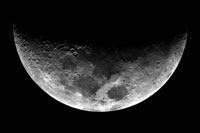Lunar race began in the 1920s
Flipping though the pages of Interplanetary Journeys by Yakov I. Perelman seems just to the point in 2007, the year that marks the 50th anniversary of the space era. The book was published in 1935. It is noteworthy that we are looking through the tenth edition of the book – the first one was issued in 1915. The book was authored by Yakov I. Perelman (Yakov Isidorovich Perelman), an outstanding educationalist and popularizer of science. It is also worthy of notice that the book contains a preface by the great Russian rocket scientist Konstantin Tsiolkovsky. The preface was originally included in the sixth edition of Interplanetary Journeys. Tsiolkovsky’s foreword reads:

“My mathematical paper entitled The Exploration of Cosmic Space by Means of Reaction Devices was first published in 1903. It was published in the fifth issue of Scientific Review, which was published in St.Petersburg. The journal’s circulation was fairly small, and nobody took notice of my work save for a few foreigners. The subsequent triumph of aviation enabled me to get back to the subject; my new work under the same title was published by The Bulletin of Aeronautics in 1911-1912. It was mostly the original work revised and expanded. Specialists paid attention to my research. However, the general public had been virtually unaware of my work until Y.I Perelman, the author of Physics Can Be Fun, set out to propagate the ideas contained therein. Perelman published his highly popular book Interplanetary Journeys in 1915. The book is a very readable yet quite scientific work on interplanetary travel. It disseminates the correct knowledge of a space rocket…”
Aside from spreading Tsiolkovsky’s ideas, the author of Interplanetary Journeys makes numerous references to other books related to the topic of space flight. He repeatedly quotes the works of the authors whose names are well known these days. For instance, he mentions a book by “the engineer S.P. Korolev” entitled The Rocket Flight in the Stratosphere (1934); The Rocket Vehicles, a book by “the engineer M.K. Tikhomirov, an inventor of a liquid-propellant rocket,” (1935); Rockets, a book by G. Languemack and V. Glushko (1935); and the works by German theoreticians of space flight e.g. I. Winkler, V. Homann, H. Oberth. He also quotes the works of Robert Hutchings Goddard, a U.S. physicist and pioneer of rocketry.
Referring to Goddard’s works, Perelman writes: “Apart from carrying out a number of experiments, Goddard also came up with his theory of a rocket flight, which he formulated independently of Tsiolkovsky’s early research into the subject. In fact, the American scientist was not aware of Tsiolkovsky’s ideas.” Right after this we come across a bridge between the romantic years of interplanetary travel and the era of practical space exploration: “Robert Goddard was well-aware of the potential of a rocket with regard to future exploration of the universe. Goddard wrote about a rocket flight to the Moon. Consequently, the U.S. press used his article forbreaking the sensational news in 1924: ‘Goddard says the launch of a first rocket to the Moon is slated for the next summer’.” That is when the lunar race kicked off.
Chapter 15 of Perelman’s Interplanetary Journeys deserves special attention. The chapter is entitled “The projects by K.E.Tsiolkovsky.”
“The launch of an interplanetary rocket will be carried out somewhere in a mountainous region. The launch pad should be equipped with a runway that goes upward at a slant of 10-12 degrees. The rocket should be put into a self-propelled vehicle e.g. an automobile running at top speed. Once a take-off run is completed, the rocket will commence its independent insertion, driven by the explosion of inflammable matter underneath. The steepness of the ascent will gradually decrease as the speed of the rocket increases. The rocket will then lower its trajectory.
Once the space vehicle pierces the atmosphere, it will start moving in a circle around the Earth at a distance of 1-2 thousand kilometers away from its surface. Its movements will remind those of a satellite. The laws of celestial mechanics clearly state that it could be achieved if the horizontal speed required for a minimal orbit around the Earth is 8 kilometers per second…”
The present-day readers may find the passage rather naive. Please do not jump to conclusions. The next paragraph of the book reads: “We have said earlier that an automobile could be used for propelling the rocket during the initial takeoff. The thing is that other means of transportation could be used for doing the same job. For instance, we could use a steam engine, a steamship, an airplane or an airship. Even cannon could do the trick. However, we would not be able to propel the rocket at a speed greater than 200 meters per second if we used any of the means mentioned above, save for a cannon.” Tsiolkovsky recommends using a rocket in lieu of an automobile or any other vehicle on four wheels. He calls that auxiliary rocket an “earthly rocket” as if to compare it to a “space rocket,” designed for an interplanetary mission.
In other words, Konstantin Tsiolkovsky managed to propose during his lifetime the concept of a two-stage rocket. According to some historians, Mikhail Tikhonravov once mentioned Perelman’s ideas with regard to a “rocket squadron” – the concept originated by Tsiolkovsky. Tikhonravov suggested that Perelman had favored a “bundle launch” of the rockets as opposed to a separate rocket launch. However, Perelman clearly says in his book that Tsiolkovsky did not touch on the issue of a “rocket squadron” nor he mentioned the issue of a “bundle launch” as the two of them discussed the contents of Chapter 15. On the contrary, Perelman’s book indicates that Tsiolkovsky spoke of a two-stage rocket, whose descriptions and representations apparently hints at those of the Soviet intercontinental ballistic missiles designed by Yangel and Utkin, not to mention the Soviet reusable space transport system Energia-Buran.
Nezavisimaya Gazeta
Translated by Guerman Grachev
Pravda.ru
Subscribe to Pravda.Ru Telegram channel, Facebook, RSS!


